Nursing Case Study: Comprehensive Care Plan for Frankley's Condition
VerifiedAdded on 2023/06/09
|9
|1975
|89
Case Study
AI Summary
This nursing case study provides a comprehensive analysis of Frankley's health condition, utilizing Gordon's functional health patterns to identify key data clusters related to sensory perception, coping skills, health perception, nutritional metabolic patterns, and activity-exercise patterns. Several nursing diagnoses are established, including breathing difficulty, poor coping skills, poor nutritional status, and physical inactivity, each linked to specific patterns within Gordon's model. Prioritization of these diagnoses is based on physiological, psychosocial, and educational domains, with acute breathing problems identified as the most critical. The care plan focuses on improving airway clearance, reducing mucus secretion, and promoting comfort, with interventions such as respiratory medication, suction secretion, and proper body alignment. The ultimate goal is to stabilize physiological parameters and encourage a healthier lifestyle. Desklib offers a wealth of resources, including similar case studies and solved assignments, to support nursing students.
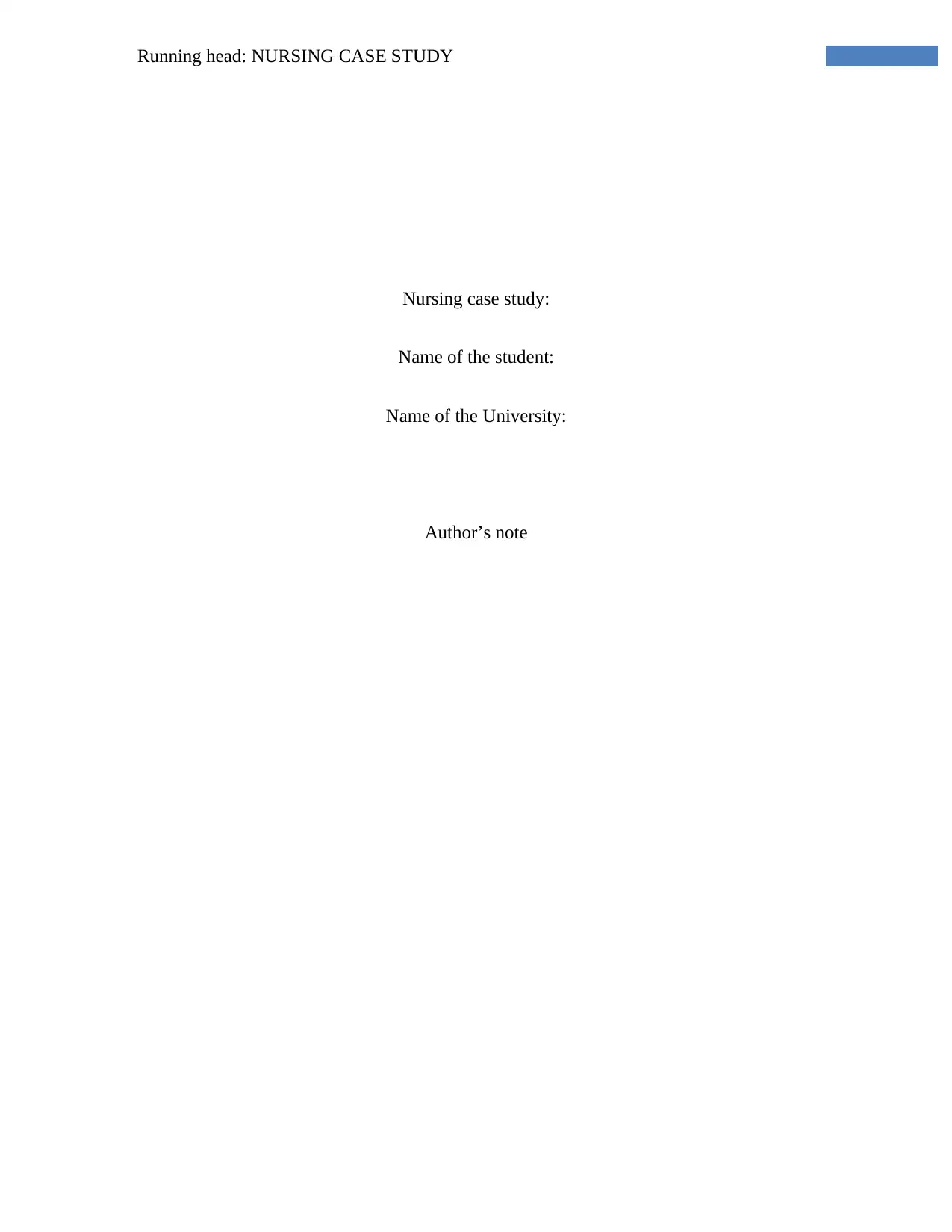
Running head: NURSING CASE STUDY
Nursing case study:
Name of the student:
Name of the University:
Author’s note
Nursing case study:
Name of the student:
Name of the University:
Author’s note
Paraphrase This Document
Need a fresh take? Get an instant paraphrase of this document with our AI Paraphraser
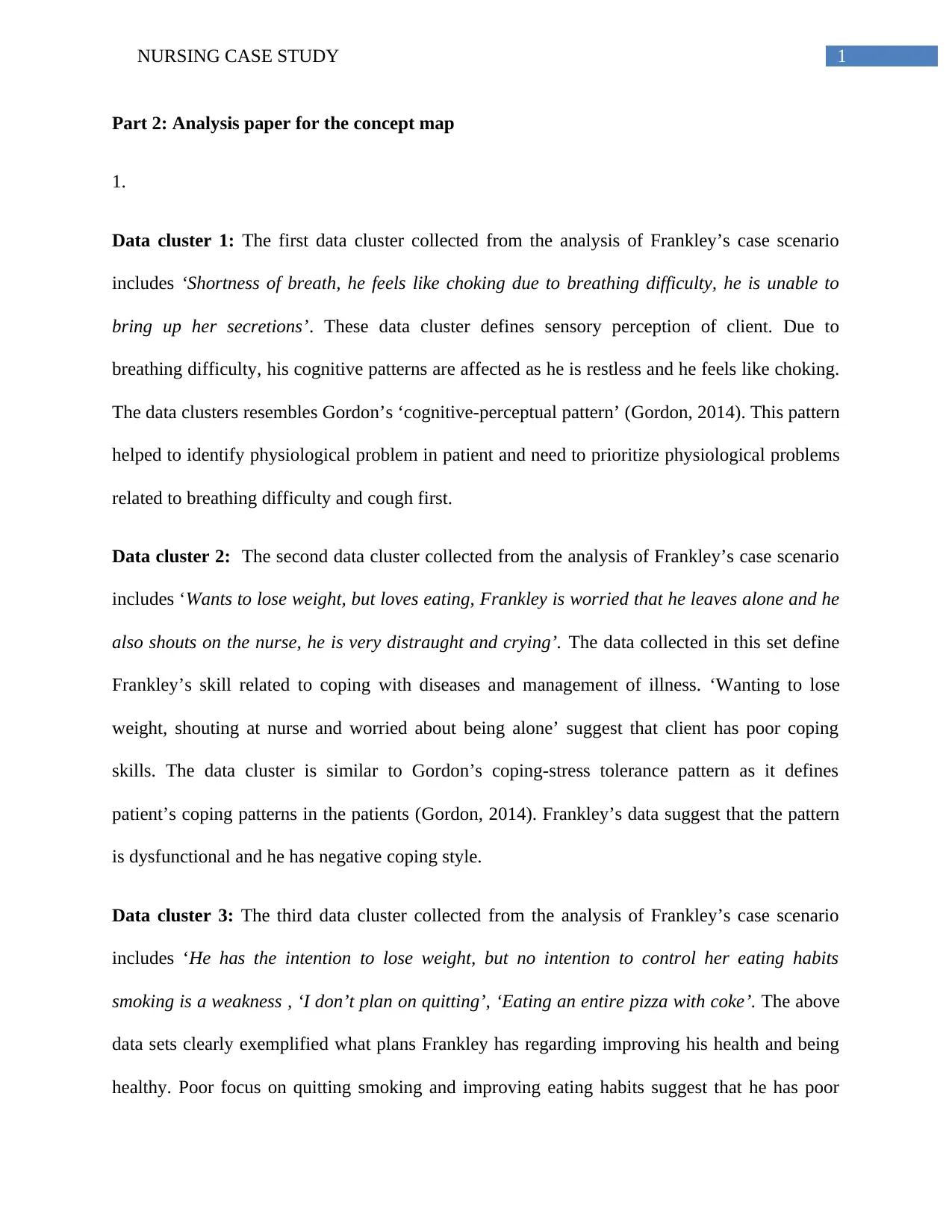
1NURSING CASE STUDY
Part 2: Analysis paper for the concept map
1.
Data cluster 1: The first data cluster collected from the analysis of Frankley’s case scenario
includes ‘Shortness of breath, he feels like choking due to breathing difficulty, he is unable to
bring up her secretions’. These data cluster defines sensory perception of client. Due to
breathing difficulty, his cognitive patterns are affected as he is restless and he feels like choking.
The data clusters resembles Gordon’s ‘cognitive-perceptual pattern’ (Gordon, 2014). This pattern
helped to identify physiological problem in patient and need to prioritize physiological problems
related to breathing difficulty and cough first.
Data cluster 2: The second data cluster collected from the analysis of Frankley’s case scenario
includes ‘Wants to lose weight, but loves eating, Frankley is worried that he leaves alone and he
also shouts on the nurse, he is very distraught and crying’. The data collected in this set define
Frankley’s skill related to coping with diseases and management of illness. ‘Wanting to lose
weight, shouting at nurse and worried about being alone’ suggest that client has poor coping
skills. The data cluster is similar to Gordon’s coping-stress tolerance pattern as it defines
patient’s coping patterns in the patients (Gordon, 2014). Frankley’s data suggest that the pattern
is dysfunctional and he has negative coping style.
Data cluster 3: The third data cluster collected from the analysis of Frankley’s case scenario
includes ‘He has the intention to lose weight, but no intention to control her eating habits
smoking is a weakness , ‘I don’t plan on quitting’, ‘Eating an entire pizza with coke’. The above
data sets clearly exemplified what plans Frankley has regarding improving his health and being
healthy. Poor focus on quitting smoking and improving eating habits suggest that he has poor
Part 2: Analysis paper for the concept map
1.
Data cluster 1: The first data cluster collected from the analysis of Frankley’s case scenario
includes ‘Shortness of breath, he feels like choking due to breathing difficulty, he is unable to
bring up her secretions’. These data cluster defines sensory perception of client. Due to
breathing difficulty, his cognitive patterns are affected as he is restless and he feels like choking.
The data clusters resembles Gordon’s ‘cognitive-perceptual pattern’ (Gordon, 2014). This pattern
helped to identify physiological problem in patient and need to prioritize physiological problems
related to breathing difficulty and cough first.
Data cluster 2: The second data cluster collected from the analysis of Frankley’s case scenario
includes ‘Wants to lose weight, but loves eating, Frankley is worried that he leaves alone and he
also shouts on the nurse, he is very distraught and crying’. The data collected in this set define
Frankley’s skill related to coping with diseases and management of illness. ‘Wanting to lose
weight, shouting at nurse and worried about being alone’ suggest that client has poor coping
skills. The data cluster is similar to Gordon’s coping-stress tolerance pattern as it defines
patient’s coping patterns in the patients (Gordon, 2014). Frankley’s data suggest that the pattern
is dysfunctional and he has negative coping style.
Data cluster 3: The third data cluster collected from the analysis of Frankley’s case scenario
includes ‘He has the intention to lose weight, but no intention to control her eating habits
smoking is a weakness , ‘I don’t plan on quitting’, ‘Eating an entire pizza with coke’. The above
data sets clearly exemplified what plans Frankley has regarding improving his health and being
healthy. Poor focus on quitting smoking and improving eating habits suggest that he has poor
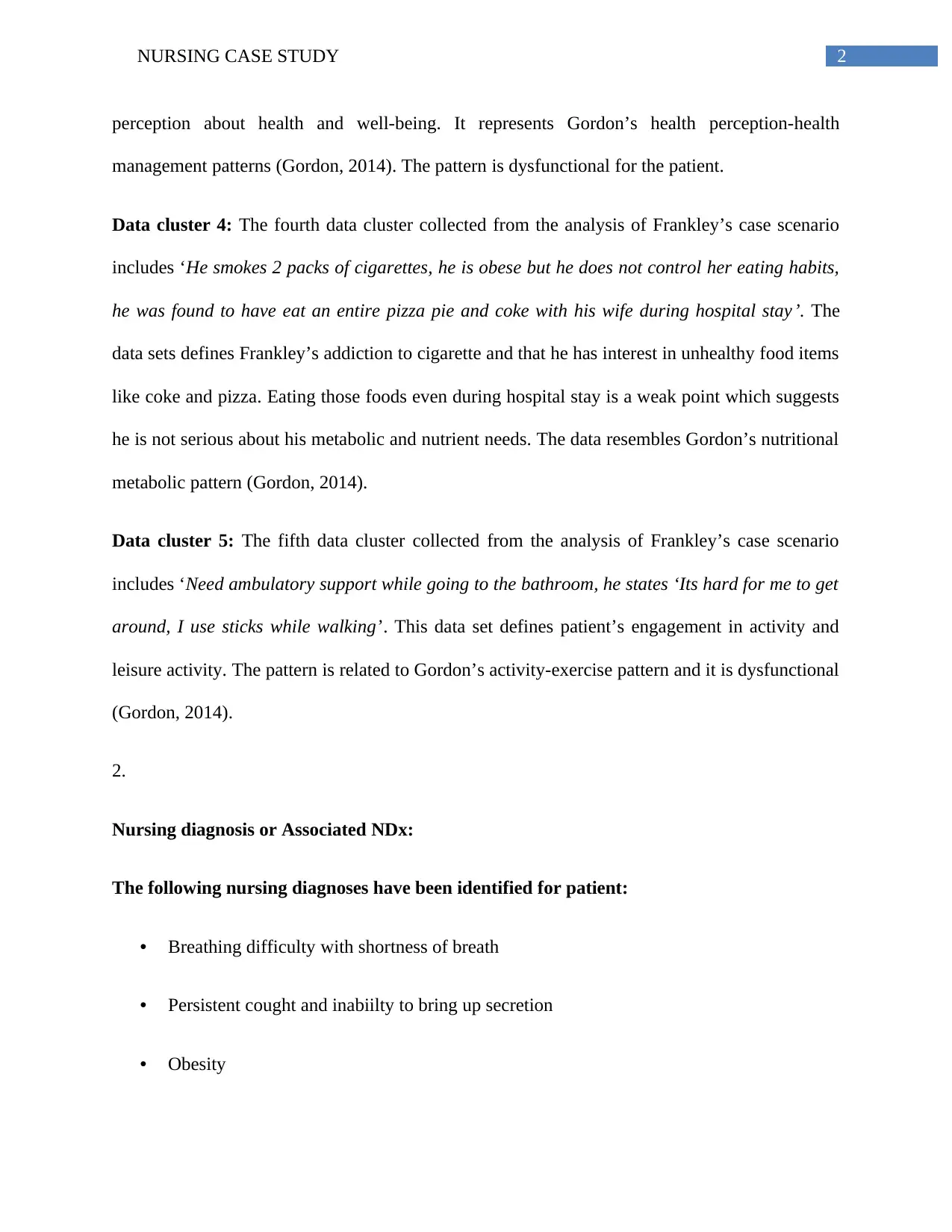
2NURSING CASE STUDY
perception about health and well-being. It represents Gordon’s health perception-health
management patterns (Gordon, 2014). The pattern is dysfunctional for the patient.
Data cluster 4: The fourth data cluster collected from the analysis of Frankley’s case scenario
includes ‘He smokes 2 packs of cigarettes, he is obese but he does not control her eating habits,
he was found to have eat an entire pizza pie and coke with his wife during hospital stay’. The
data sets defines Frankley’s addiction to cigarette and that he has interest in unhealthy food items
like coke and pizza. Eating those foods even during hospital stay is a weak point which suggests
he is not serious about his metabolic and nutrient needs. The data resembles Gordon’s nutritional
metabolic pattern (Gordon, 2014).
Data cluster 5: The fifth data cluster collected from the analysis of Frankley’s case scenario
includes ‘Need ambulatory support while going to the bathroom, he states ‘Its hard for me to get
around, I use sticks while walking’. This data set defines patient’s engagement in activity and
leisure activity. The pattern is related to Gordon’s activity-exercise pattern and it is dysfunctional
(Gordon, 2014).
2.
Nursing diagnosis or Associated NDx:
The following nursing diagnoses have been identified for patient:
• Breathing difficulty with shortness of breath
• Persistent cought and inabiilty to bring up secretion
• Obesity
perception about health and well-being. It represents Gordon’s health perception-health
management patterns (Gordon, 2014). The pattern is dysfunctional for the patient.
Data cluster 4: The fourth data cluster collected from the analysis of Frankley’s case scenario
includes ‘He smokes 2 packs of cigarettes, he is obese but he does not control her eating habits,
he was found to have eat an entire pizza pie and coke with his wife during hospital stay’. The
data sets defines Frankley’s addiction to cigarette and that he has interest in unhealthy food items
like coke and pizza. Eating those foods even during hospital stay is a weak point which suggests
he is not serious about his metabolic and nutrient needs. The data resembles Gordon’s nutritional
metabolic pattern (Gordon, 2014).
Data cluster 5: The fifth data cluster collected from the analysis of Frankley’s case scenario
includes ‘Need ambulatory support while going to the bathroom, he states ‘Its hard for me to get
around, I use sticks while walking’. This data set defines patient’s engagement in activity and
leisure activity. The pattern is related to Gordon’s activity-exercise pattern and it is dysfunctional
(Gordon, 2014).
2.
Nursing diagnosis or Associated NDx:
The following nursing diagnoses have been identified for patient:
• Breathing difficulty with shortness of breath
• Persistent cought and inabiilty to bring up secretion
• Obesity
⊘ This is a preview!⊘
Do you want full access?
Subscribe today to unlock all pages.

Trusted by 1+ million students worldwide
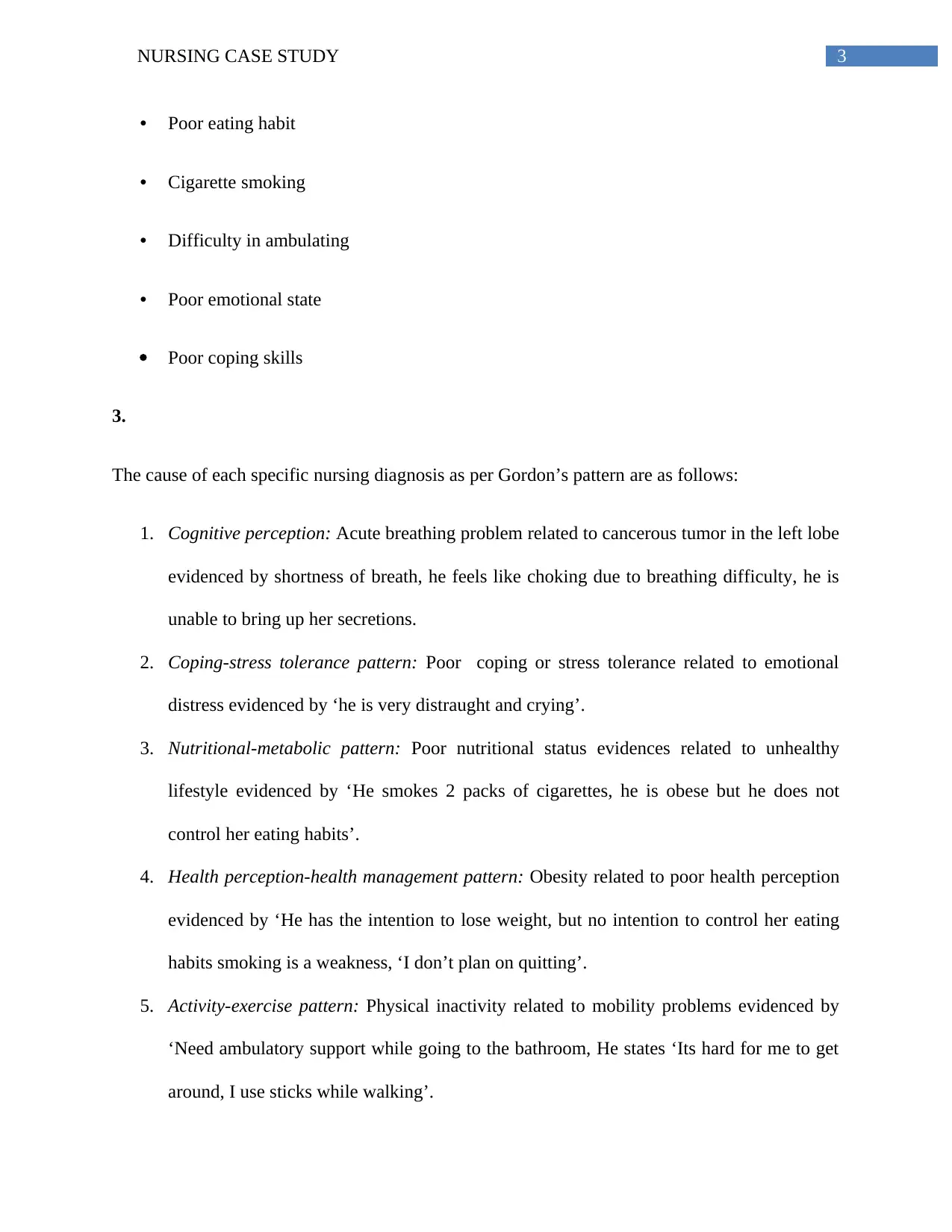
3NURSING CASE STUDY
• Poor eating habit
• Cigarette smoking
• Difficulty in ambulating
• Poor emotional state
Poor coping skills
3.
The cause of each specific nursing diagnosis as per Gordon’s pattern are as follows:
1. Cognitive perception: Acute breathing problem related to cancerous tumor in the left lobe
evidenced by shortness of breath, he feels like choking due to breathing difficulty, he is
unable to bring up her secretions.
2. Coping-stress tolerance pattern: Poor coping or stress tolerance related to emotional
distress evidenced by ‘he is very distraught and crying’.
3. Nutritional-metabolic pattern: Poor nutritional status evidences related to unhealthy
lifestyle evidenced by ‘He smokes 2 packs of cigarettes, he is obese but he does not
control her eating habits’.
4. Health perception-health management pattern: Obesity related to poor health perception
evidenced by ‘He has the intention to lose weight, but no intention to control her eating
habits smoking is a weakness, ‘I don’t plan on quitting’.
5. Activity-exercise pattern: Physical inactivity related to mobility problems evidenced by
‘Need ambulatory support while going to the bathroom, He states ‘Its hard for me to get
around, I use sticks while walking’.
• Poor eating habit
• Cigarette smoking
• Difficulty in ambulating
• Poor emotional state
Poor coping skills
3.
The cause of each specific nursing diagnosis as per Gordon’s pattern are as follows:
1. Cognitive perception: Acute breathing problem related to cancerous tumor in the left lobe
evidenced by shortness of breath, he feels like choking due to breathing difficulty, he is
unable to bring up her secretions.
2. Coping-stress tolerance pattern: Poor coping or stress tolerance related to emotional
distress evidenced by ‘he is very distraught and crying’.
3. Nutritional-metabolic pattern: Poor nutritional status evidences related to unhealthy
lifestyle evidenced by ‘He smokes 2 packs of cigarettes, he is obese but he does not
control her eating habits’.
4. Health perception-health management pattern: Obesity related to poor health perception
evidenced by ‘He has the intention to lose weight, but no intention to control her eating
habits smoking is a weakness, ‘I don’t plan on quitting’.
5. Activity-exercise pattern: Physical inactivity related to mobility problems evidenced by
‘Need ambulatory support while going to the bathroom, He states ‘Its hard for me to get
around, I use sticks while walking’.
Paraphrase This Document
Need a fresh take? Get an instant paraphrase of this document with our AI Paraphraser
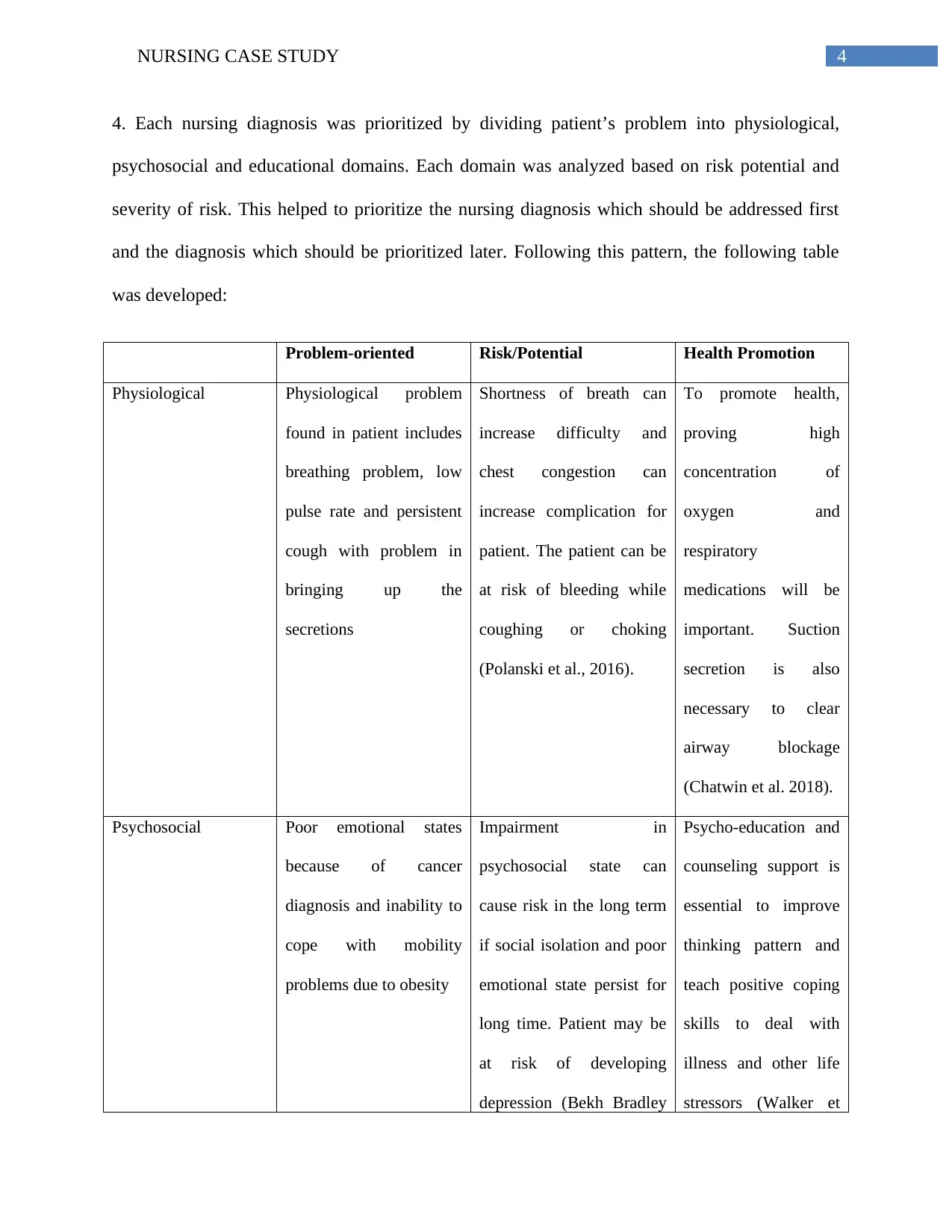
4NURSING CASE STUDY
4. Each nursing diagnosis was prioritized by dividing patient’s problem into physiological,
psychosocial and educational domains. Each domain was analyzed based on risk potential and
severity of risk. This helped to prioritize the nursing diagnosis which should be addressed first
and the diagnosis which should be prioritized later. Following this pattern, the following table
was developed:
Problem-oriented Risk/Potential Health Promotion
Physiological Physiological problem
found in patient includes
breathing problem, low
pulse rate and persistent
cough with problem in
bringing up the
secretions
Shortness of breath can
increase difficulty and
chest congestion can
increase complication for
patient. The patient can be
at risk of bleeding while
coughing or choking
(Polanski et al., 2016).
To promote health,
proving high
concentration of
oxygen and
respiratory
medications will be
important. Suction
secretion is also
necessary to clear
airway blockage
(Chatwin et al. 2018).
Psychosocial Poor emotional states
because of cancer
diagnosis and inability to
cope with mobility
problems due to obesity
Impairment in
psychosocial state can
cause risk in the long term
if social isolation and poor
emotional state persist for
long time. Patient may be
at risk of developing
depression (Bekh Bradley
Psycho-education and
counseling support is
essential to improve
thinking pattern and
teach positive coping
skills to deal with
illness and other life
stressors (Walker et
4. Each nursing diagnosis was prioritized by dividing patient’s problem into physiological,
psychosocial and educational domains. Each domain was analyzed based on risk potential and
severity of risk. This helped to prioritize the nursing diagnosis which should be addressed first
and the diagnosis which should be prioritized later. Following this pattern, the following table
was developed:
Problem-oriented Risk/Potential Health Promotion
Physiological Physiological problem
found in patient includes
breathing problem, low
pulse rate and persistent
cough with problem in
bringing up the
secretions
Shortness of breath can
increase difficulty and
chest congestion can
increase complication for
patient. The patient can be
at risk of bleeding while
coughing or choking
(Polanski et al., 2016).
To promote health,
proving high
concentration of
oxygen and
respiratory
medications will be
important. Suction
secretion is also
necessary to clear
airway blockage
(Chatwin et al. 2018).
Psychosocial Poor emotional states
because of cancer
diagnosis and inability to
cope with mobility
problems due to obesity
Impairment in
psychosocial state can
cause risk in the long term
if social isolation and poor
emotional state persist for
long time. Patient may be
at risk of developing
depression (Bekh Bradley
Psycho-education and
counseling support is
essential to improve
thinking pattern and
teach positive coping
skills to deal with
illness and other life
stressors (Walker et

5NURSING CASE STUDY
et al., 2011) al., 2013)
Educational Poor intention to quit
smoking and unhealthy
eating habit has been
identified as one of the
educational problem for
patient
Continuing with smoking
can further cause problem
for Frankeley as he is a
patient diagnosed with
lung cancer. People who
continue to smoke after
diagnosis of the cancer
doubles their risk of dying
(Cataldo, Dubey &
Prochaska, 2010).
Smoking cessation is
an integral part of
treatment and
encouraging patient to
quit smoking is
essential to provide
health benefit to
patient (Cataldo,
Dubey & Prochaska,
2010).
6. The nursing diagnosis related to acute breathing problem was identified as the most
important to address. This was identifying by analyzing the consequence of persistent
breathing problems and its impact on respiratory system of patient. As patient is at risk of
choking and even dying due to breathing problem, this nursing problem can cause
immediate risk to patient (Ignatavicius & Workman, 2015). Hence, addressing breathing
problem was prioritized first.
7. Poor nutritional status is the second important nursing diagnosis because Frankley takes 2
packs cigarette and this can increase his risk of dying earlier than without smoking.
Smoking cessation can yield both immediate and long-term health benefits (Amato et al.,
2015).
8. Poor mobility is least important to address as when client will modify his lifestyle
patterns and lose weight, the problem can be eliminated.
et al., 2011) al., 2013)
Educational Poor intention to quit
smoking and unhealthy
eating habit has been
identified as one of the
educational problem for
patient
Continuing with smoking
can further cause problem
for Frankeley as he is a
patient diagnosed with
lung cancer. People who
continue to smoke after
diagnosis of the cancer
doubles their risk of dying
(Cataldo, Dubey &
Prochaska, 2010).
Smoking cessation is
an integral part of
treatment and
encouraging patient to
quit smoking is
essential to provide
health benefit to
patient (Cataldo,
Dubey & Prochaska,
2010).
6. The nursing diagnosis related to acute breathing problem was identified as the most
important to address. This was identifying by analyzing the consequence of persistent
breathing problems and its impact on respiratory system of patient. As patient is at risk of
choking and even dying due to breathing problem, this nursing problem can cause
immediate risk to patient (Ignatavicius & Workman, 2015). Hence, addressing breathing
problem was prioritized first.
7. Poor nutritional status is the second important nursing diagnosis because Frankley takes 2
packs cigarette and this can increase his risk of dying earlier than without smoking.
Smoking cessation can yield both immediate and long-term health benefits (Amato et al.,
2015).
8. Poor mobility is least important to address as when client will modify his lifestyle
patterns and lose weight, the problem can be eliminated.
⊘ This is a preview!⊘
Do you want full access?
Subscribe today to unlock all pages.

Trusted by 1+ million students worldwide
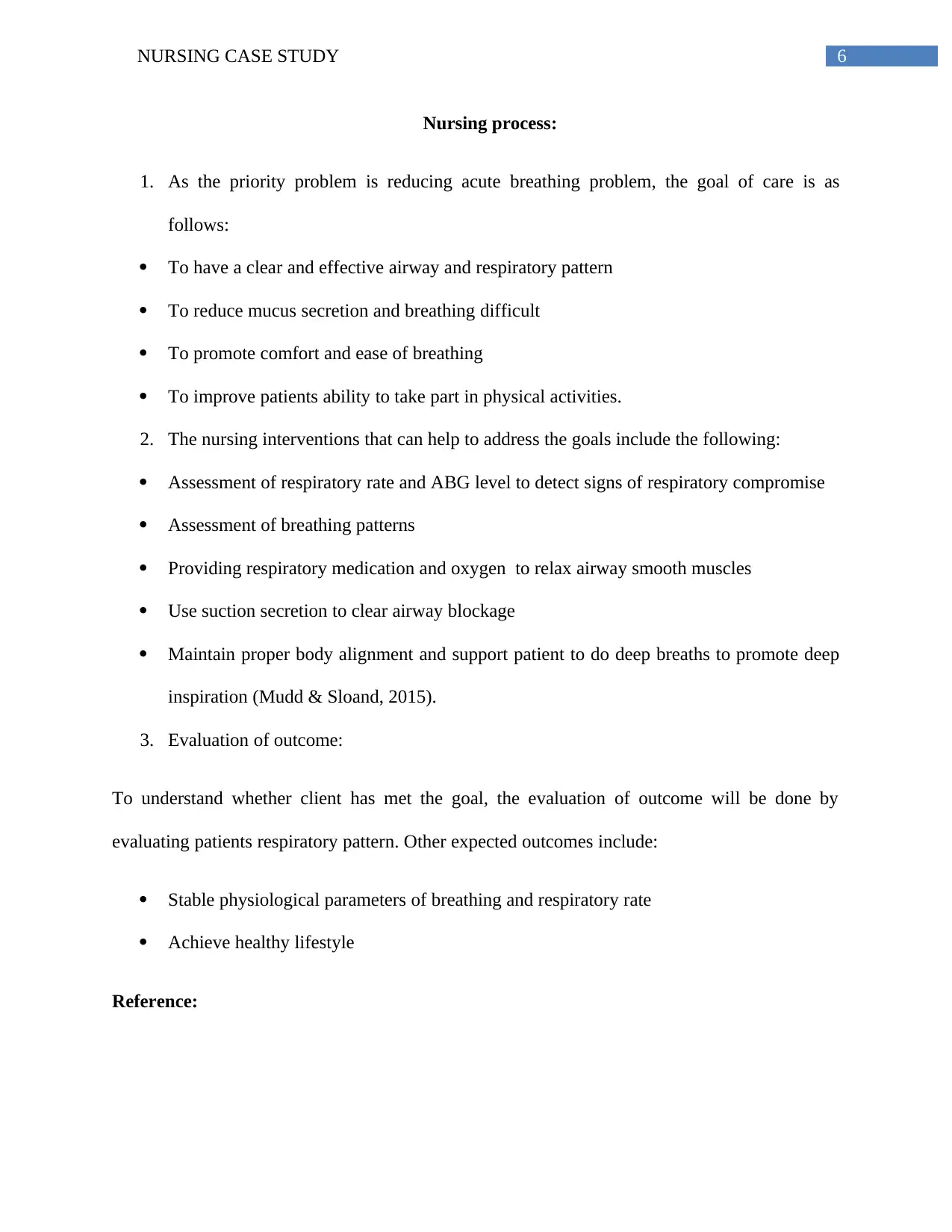
6NURSING CASE STUDY
Nursing process:
1. As the priority problem is reducing acute breathing problem, the goal of care is as
follows:
To have a clear and effective airway and respiratory pattern
To reduce mucus secretion and breathing difficult
To promote comfort and ease of breathing
To improve patients ability to take part in physical activities.
2. The nursing interventions that can help to address the goals include the following:
Assessment of respiratory rate and ABG level to detect signs of respiratory compromise
Assessment of breathing patterns
Providing respiratory medication and oxygen to relax airway smooth muscles
Use suction secretion to clear airway blockage
Maintain proper body alignment and support patient to do deep breaths to promote deep
inspiration (Mudd & Sloand, 2015).
3. Evaluation of outcome:
To understand whether client has met the goal, the evaluation of outcome will be done by
evaluating patients respiratory pattern. Other expected outcomes include:
Stable physiological parameters of breathing and respiratory rate
Achieve healthy lifestyle
Reference:
Nursing process:
1. As the priority problem is reducing acute breathing problem, the goal of care is as
follows:
To have a clear and effective airway and respiratory pattern
To reduce mucus secretion and breathing difficult
To promote comfort and ease of breathing
To improve patients ability to take part in physical activities.
2. The nursing interventions that can help to address the goals include the following:
Assessment of respiratory rate and ABG level to detect signs of respiratory compromise
Assessment of breathing patterns
Providing respiratory medication and oxygen to relax airway smooth muscles
Use suction secretion to clear airway blockage
Maintain proper body alignment and support patient to do deep breaths to promote deep
inspiration (Mudd & Sloand, 2015).
3. Evaluation of outcome:
To understand whether client has met the goal, the evaluation of outcome will be done by
evaluating patients respiratory pattern. Other expected outcomes include:
Stable physiological parameters of breathing and respiratory rate
Achieve healthy lifestyle
Reference:
Paraphrase This Document
Need a fresh take? Get an instant paraphrase of this document with our AI Paraphraser
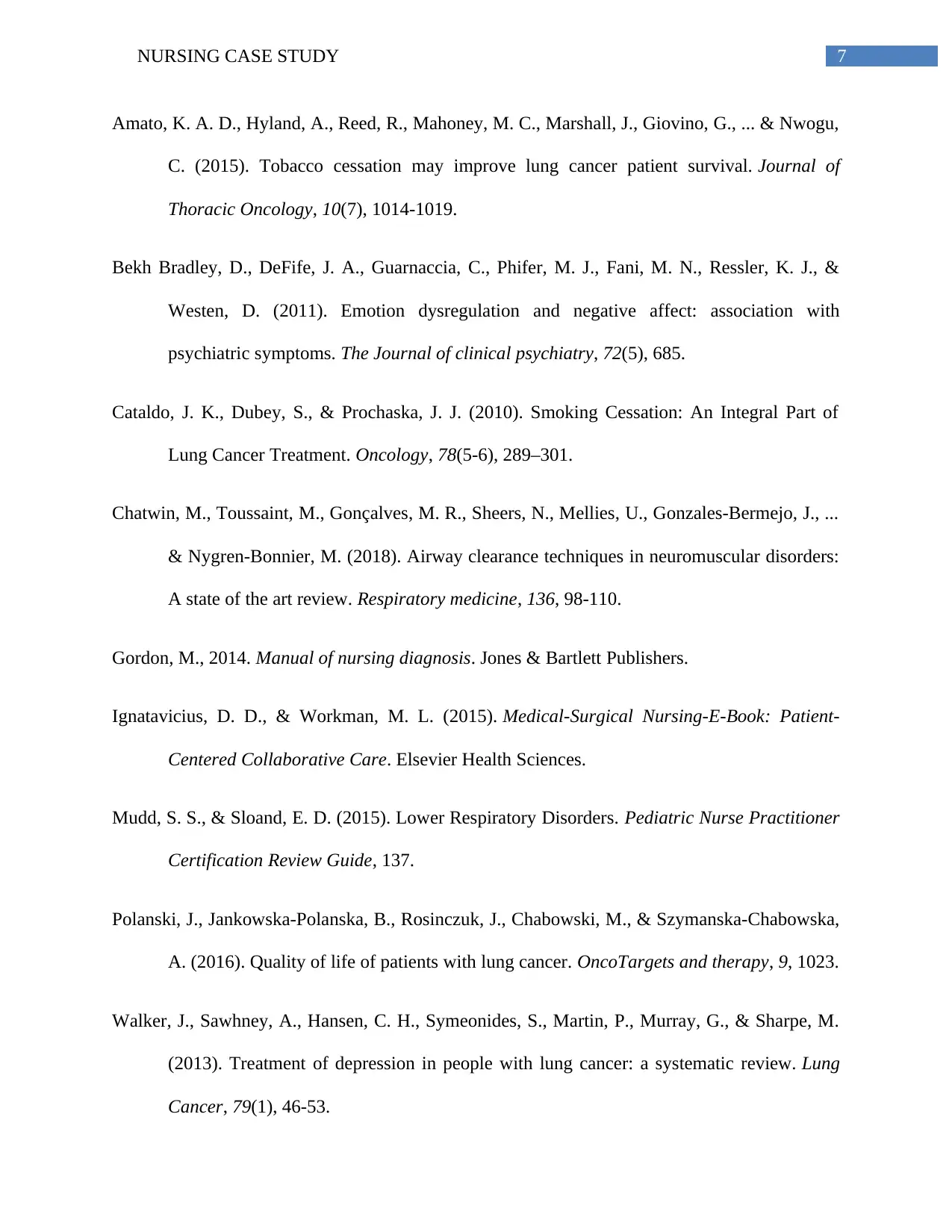
7NURSING CASE STUDY
Amato, K. A. D., Hyland, A., Reed, R., Mahoney, M. C., Marshall, J., Giovino, G., ... & Nwogu,
C. (2015). Tobacco cessation may improve lung cancer patient survival. Journal of
Thoracic Oncology, 10(7), 1014-1019.
Bekh Bradley, D., DeFife, J. A., Guarnaccia, C., Phifer, M. J., Fani, M. N., Ressler, K. J., &
Westen, D. (2011). Emotion dysregulation and negative affect: association with
psychiatric symptoms. The Journal of clinical psychiatry, 72(5), 685.
Cataldo, J. K., Dubey, S., & Prochaska, J. J. (2010). Smoking Cessation: An Integral Part of
Lung Cancer Treatment. Oncology, 78(5-6), 289–301.
Chatwin, M., Toussaint, M., Gonçalves, M. R., Sheers, N., Mellies, U., Gonzales-Bermejo, J., ...
& Nygren-Bonnier, M. (2018). Airway clearance techniques in neuromuscular disorders:
A state of the art review. Respiratory medicine, 136, 98-110.
Gordon, M., 2014. Manual of nursing diagnosis. Jones & Bartlett Publishers.
Ignatavicius, D. D., & Workman, M. L. (2015). Medical-Surgical Nursing-E-Book: Patient-
Centered Collaborative Care. Elsevier Health Sciences.
Mudd, S. S., & Sloand, E. D. (2015). Lower Respiratory Disorders. Pediatric Nurse Practitioner
Certification Review Guide, 137.
Polanski, J., Jankowska-Polanska, B., Rosinczuk, J., Chabowski, M., & Szymanska-Chabowska,
A. (2016). Quality of life of patients with lung cancer. OncoTargets and therapy, 9, 1023.
Walker, J., Sawhney, A., Hansen, C. H., Symeonides, S., Martin, P., Murray, G., & Sharpe, M.
(2013). Treatment of depression in people with lung cancer: a systematic review. Lung
Cancer, 79(1), 46-53.
Amato, K. A. D., Hyland, A., Reed, R., Mahoney, M. C., Marshall, J., Giovino, G., ... & Nwogu,
C. (2015). Tobacco cessation may improve lung cancer patient survival. Journal of
Thoracic Oncology, 10(7), 1014-1019.
Bekh Bradley, D., DeFife, J. A., Guarnaccia, C., Phifer, M. J., Fani, M. N., Ressler, K. J., &
Westen, D. (2011). Emotion dysregulation and negative affect: association with
psychiatric symptoms. The Journal of clinical psychiatry, 72(5), 685.
Cataldo, J. K., Dubey, S., & Prochaska, J. J. (2010). Smoking Cessation: An Integral Part of
Lung Cancer Treatment. Oncology, 78(5-6), 289–301.
Chatwin, M., Toussaint, M., Gonçalves, M. R., Sheers, N., Mellies, U., Gonzales-Bermejo, J., ...
& Nygren-Bonnier, M. (2018). Airway clearance techniques in neuromuscular disorders:
A state of the art review. Respiratory medicine, 136, 98-110.
Gordon, M., 2014. Manual of nursing diagnosis. Jones & Bartlett Publishers.
Ignatavicius, D. D., & Workman, M. L. (2015). Medical-Surgical Nursing-E-Book: Patient-
Centered Collaborative Care. Elsevier Health Sciences.
Mudd, S. S., & Sloand, E. D. (2015). Lower Respiratory Disorders. Pediatric Nurse Practitioner
Certification Review Guide, 137.
Polanski, J., Jankowska-Polanska, B., Rosinczuk, J., Chabowski, M., & Szymanska-Chabowska,
A. (2016). Quality of life of patients with lung cancer. OncoTargets and therapy, 9, 1023.
Walker, J., Sawhney, A., Hansen, C. H., Symeonides, S., Martin, P., Murray, G., & Sharpe, M.
(2013). Treatment of depression in people with lung cancer: a systematic review. Lung
Cancer, 79(1), 46-53.

8NURSING CASE STUDY
⊘ This is a preview!⊘
Do you want full access?
Subscribe today to unlock all pages.

Trusted by 1+ million students worldwide
1 out of 9
Your All-in-One AI-Powered Toolkit for Academic Success.
+13062052269
info@desklib.com
Available 24*7 on WhatsApp / Email
![[object Object]](/_next/static/media/star-bottom.7253800d.svg)
Unlock your academic potential
Copyright © 2020–2025 A2Z Services. All Rights Reserved. Developed and managed by ZUCOL.

